Table of Contents
LIBRARIES: LARGE, SMALL, GRAND, AND ROYAL
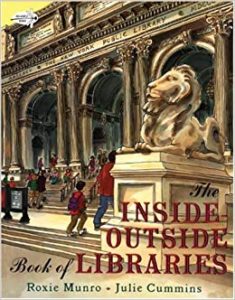
|
Juli Cummins’s The Inside-Outside Book of Libraries (Dragonfly Books, 2008) is an exploration of thirteen very different libraries, with detailed illustrations showing both the inside and outside of each. Included are a library on board an aircraft carrier, a tiny one-room library on an island off North Carolina, a prison library, a library for the blind, and a library that lends tools rather than books. For ages 6-9. |

|
Barb Rosenstock’s Thomas Jefferson Builds a Library (Calkins Creek, 2013) explains how young Tom Jefferson discovered that he loved books and eventually amassed the wonderful collection that became the Library of Congress. A delightful and cleverly designed picture book for ages 6-10. |
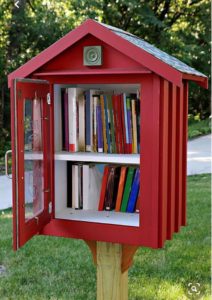 |
The Little Free Library is a community project to establish tiny free book-exchange libraries in towns across the nation. The website has information, suggestions, a gallery of tiny libraries, building plans, and more. A terrific group project. |
| The World’s Most Beautiful Libraries is photo collection of some truly gorgeous libraries. Only one missing is Hogwarts. |
LIBRARIANS: STRONG AND GOOD
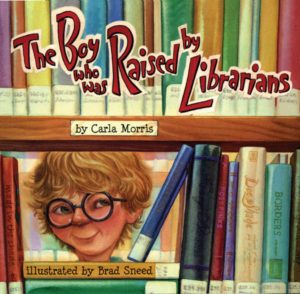
|
In Carla Morris’s The Boy Who Was Raised by Librarians (Peachtree Publishers, 2007), Melvin, a curious bespectacled little boy, loves the library and its three librarians (Marge, Leeola, and Betty) who are a never-failing source of information and support. They help Melvin identify the creepy bugs in his collection (which promptly escape from the jar), bolster him by finding helpful passages from Organic Gardening when he’s chosen to play an eggplant in the school play, and provide resources when he competes in the school spelling bee. Eventually Marvin grows up and goes to college, and as the book ends, a new little boy arrives at the library, where Marvin is now a librarian. For ages 4-9. |
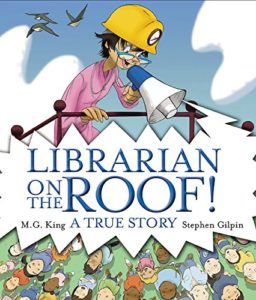
|
In M.G. King’s Librarian on the Roof! (Albert Whitman and Company, 2010), when the new librarian arrives at the library in Lockhart, Texas, she finds to her dismay that no children use it. Determined to create a children’s room, she decides to camp out on the library roof until enough money is raised for a library addition – and eventually, inspired, the town rallies round. Based on a true story. For ages 6-9. |
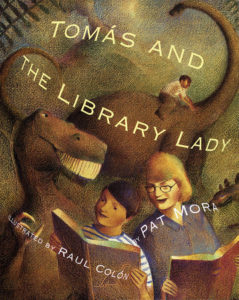
|
Pat Mora’s Tomas and the Library Lady (Dragonfly Books, 2000) is the story of Tomas, child of a family of migrant workers, who – having heard all the stories that his grandfather, Papa Grande, has to tell – is sent to the library to find more. There he meets an understanding librarian who introduces Tomas to an entire world of books. The book is based on the life story of Mexican-American author and educator Tomas Rivers. For ages 4-8. |
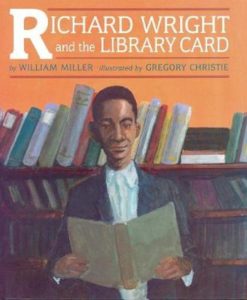
|
William Miller’s Richard Wright and the Library Card (Lee & Low, 1999) is a story taken from author Wright’s autobiographical Black Boy, which details his experiences growing up black in the segregated South of the 1920s. Miller’s picture book describes how Wright as a teenager was barred from checking out books from the local public library – a privilege accorded only to whites – until a white co-worker helped him circumvent the rules. Books, for Wright, are a ticket to freedom, and by the end of the book, with a wealth of reading under his belt, he’s on his way to Chicago to start a new life. For ages 6-10. |
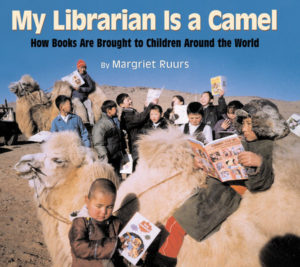
|
How would you get your library books if you lived, say, on the islands off the coast of Finland or in Mongolia’s Gobi Desert? Margriet Ruurs’s My Librarian is a Camel (Boyds Mills Press, 2005) describes how isolated areas in thirteen different countries get access to books – for example, via elephant, camel, boat, donkey cart, and wheelbarrow. The book is illustrated with color photographs; sidebars provide maps and information on each of the featured countries. For ages 8-12. |
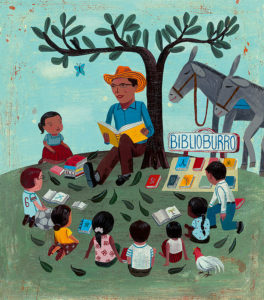
|
Based on the real-life work of librarian Luis Soriano, Monica Brown’s Waiting for the Biblioburro (Tricycle Press, 2011), is the picture-book story of Ana who lives with her family in a tiny village in rural Colombia. Ana loves stories and longs for books, and her life is changed when a wonderful man arrives with two book-laden burros. For ages 4-8. |
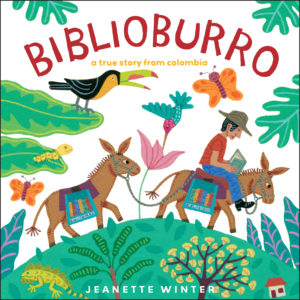
|
Luis Soriano himself is the protagonist of Jeanette Winter’s picture book Biblioburro (Beach Lane Books, 2010). Luis so loves to read that his house can barely hold his piles of books – so he loads up his burros and sets off for faraway villages to share his love of books and reading with the children there. The message is not only pro-book, it’s that one determined person can make a difference. For ages 4-8. |
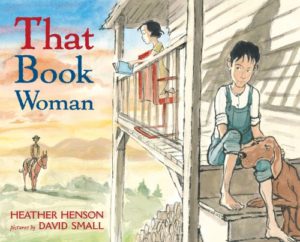
|
Heather Henson’s That Book Woman (Atheneum Books for Young Readers, 2008) is the story of young Cal, who lives with his parents and sister Lark high in the mountains of Appalachia. When the Book Woman arrives on horseback with her pack of books, his sister Lark – “the readenest child you ever did see” – is delighted, but Cal insists that books are not for him. Finally, though, impressed by the Book Woman’s determination, he asks Lark to teach him to read. The book is based on the Pack Horse Librarians of the 1930s, participants in a WPA program to deliver books to people in isolated regions. For ages 7-11. |
| For more on the Pack Horse Librarians, see this article from the Smithsonian. | |
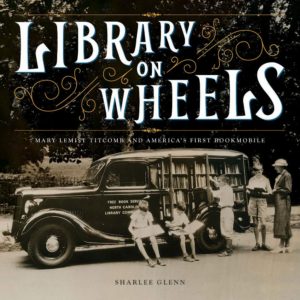 |
By Sharlee Glenn, Library on Wheels (Harry N. Abrams, 2018) is the story of Mary Lemist Titcomb and America’s first bookmobile, illustrated with great period photos. For ages 8-12. |
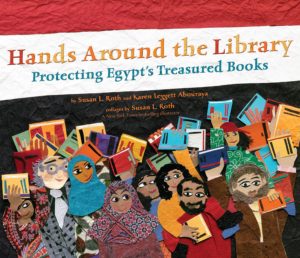
|
By Susan Roth and Karen Leggett Abouraya, Hands Around the Library (Dial, 2012) is the story of how Egyptian students and librarians literally joined hands and formed a ring around the Bibliotheca Alexandrina to protect it during the overthrow of the Egyptian government in the 2011 Arab Spring uprisings. The simple text is accompanied by bright blended collages. An appendix has information about ancient and modern libraries and the Egyptian Revolution of January, 2011. For ages 6-9. |
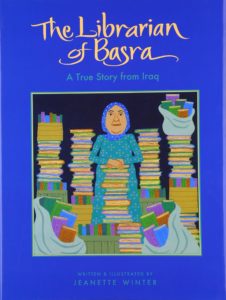
|
Jeanette Winter’s The Librarian of Basra (Harcourt Children’s Books, 2005) is the story of librarian Alia Muhammad Baker who, in the days of the Iraq war, managed to move all her library’s books to safety. An inspirational story with a lot of opportunity for discussion. For ages 7-10. |
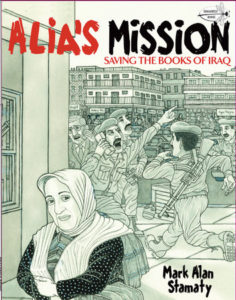
|
Also see Alia’s Mission by Mark Alan Stamaty (Knopf Books for Young Readers, 2004), a graphic-novel account of Baker’s accomplishment, for ages 9-13. |

|
In Natalie Kinsey-Warnock’s Lumber Camp Library (HarperCollins, 2003), set in early twentieth-century Vermont, ten-year-old Ruby lives with her family in a lumber camp. Then her father drowns in a logging accident, her mother takes a job as lumber-camp cook, and Ruby is forced to drop out of school to take care of her ten younger siblings. She’s miserable – until Mrs. Graham, a neighbor, offers to share her books. Soon Ruby is teaching some of the lumberjacks how to read – and eventually she goes on to become a teacher and to found a lumber camp library. For ages 8-11. |
| Can you name a famous librarian? See the top 25 in history. |
